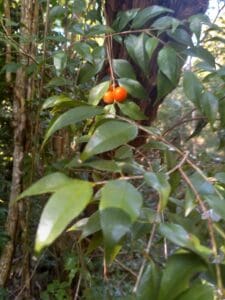
During the Christmas season in the Virgin Islands, native foods become high on the list for eating at festival events. The history of Virgin Islands cuisine can be traced back from the Middle Passage of the enslaved Africans. In fact, one can go a little further back and say native foods can be traced back to the first inhabitants of the Virgin Islands. The ancient Amerindians lived off seafood such as fish, whelks, conch, etc., and the wild native fruits and plants of the islands.

Today, Virgin Islanders still eat a variety of seafoods. They also eat the roots of plants, fruits, ground provisions, etc. The guavaberry (Myrciaria floribunda), a wild native tree, was also one of the fruits the Amerindians ate. The fruit today is still eaten. A drink as well as rum is made from the fruit. The rum made from the guavaberry fruit is popular among locals during the Christmas season.
Believe me, guavaberry rum is so popular during the Christmas season that there is a song written about it by Stanley and the Ten Sleepless Knights that says, “On the first day of Christmas, my true love gave to me a jimmy john, a guavaberry…” Another song about the plant says, “Good morning, good morning, I come for my guavaberry.” This native fruit is tied to our culture. Also, carol singers who went about singing the guavaberry song from door to door were bound to receive a small sample of the guavaberry liqueur, tarts, at each door. I am talking about the yesteryears when this Virgin Islands’ tradition was practiced.
However, I really want to talk about Red Grout. Red Grout is one of our native desserts. In fact, the dessert is the signature of the Virgin Islands culture. This dessert of Danish origin is known in the Virgin Islands locally as Red Grout, which is made from the sago palm (Cycas revoluta). It is also called Rodgrod (Danish), rote Grutze (German), or rode Grutt, which means “red groats.” It is a sweet fruit dish from Denmark and Northern Germany.
In Denmark, sago and semolina are used to make the Red Grout. However, the main ingredients are potato starch and red summer berries, such as raspberries, strawberries, redcurrant, blackcurrant, blackberries, and stoned black cherries. According to one source, the essential flavor of Red Grout can be achieved by using redcurrant or with a small amount of blackcurrant. Sugar is also used to intensify the flavor of the Red Grout. Nonetheless, the amounts of sago, starch, and semolina can differ with one’s taste and depend on how much you add to the ingredients to make Red Grout dessert.

Groat, sago, or grit must be soaked before it can be used to make Red Grout. It is basically that of a pudding. The fruits are briefly cooked with some sugar. The pudding-like mass should be cooled down so that the starch can be dissolved into the fruit juice. Or you can use water to stir into it without clumping the pudding mass. Also, a second cooking of the Red Grout is required of one to two minutes in order to start the gelatinization, which removes the remaining white starch to be cleared up.
In Denmark, Red Grout is served hot or cold as a dessert. It has milk in it, or a mixture of milk, vanilla sugar, vanilla sauce, (whipped) cream, vanilla ice cream, and custard added to balance the refreshing taste of the fruit acids. Traditionally in the Virgin Islands, Red Grout is served on March 31, a local holiday known as Transfer Day. Nevertheless, one can eat Red Grout anytime of the year, but serving it on Transfer Day ties our history with Denmark, which first introduced the tapioca dessert in the Danish West Indies.

The sago palm was not commonly grown in the Virgin Islands. As a result, tapioca (starch obtained from the root of the cassava) became a substitute as part of the ingredients for our local Red Grout. Locals cooked tapioca and then colored it with red juice made from the fruit of the prickly pear (Opuntia delleni). Prickly pear grows wild in certain areas of the Virgin Islands and can be found in backyard gardens. The plant also has medicinal and food value, such as using prickly pear in fungi making or in “chopup.”
In other words, chopup is a term used in chopping greens in small pieces where in some Caribbean cultures, such as Antigua, prickly pear was part of the ingredients. The local flavor for Red Grout in the Virgin Islands is guava, unlike the Danish who use berries such as raspberries. According to the late Amy Blackwood Mackay, a native Crucian, “the Red Grout dessert is chilled in a mold and served with a cream sauce.”
In her cookbook, titled “Le Awe Cook: ‘Let Us Cook,’” is a recipe for how to make Red Grout.
Red Grout
2 ripe prickly pear fruit or 1/8 teaspoon red food coloring
1 quart water
6-8 firm ripe guavas
½ cup sugar (optional)
1 cup sago or quick-cooking tapioca
½ cup raisins
½ cup prunes, pitted
Pinch salt
Prepare prickly pear fruit by rubbing off all spines. Cut open and place in pan. Pour 1 cup boiling water over fruit and allow to steep for several minutes. Squeeze all liquid from fruit, strain well, and set liquid aside for use in coloring dessert later. Remove stems from guavas and cut fruit into pieces. Put to boil for 10 minutes on medium heat with water to cover, adding sugar if desired. Remove from heat and strain, reserving liquid and discarding pulp and seeds.
Return to pot on low heat, adding sago or tapioca and stirring vigorously to prevent lumping, and continue to cook until grains are crystal clear. Add raisins, prunes, and salt, stir well, and cook for 5 minutes longer. Add prickly pear liquid or red coloring, pour into mold, and chill. Serve with cream sauce.
This Christmas season, make Red Grout part of your menu. It is an authentic Virgin Islands native dessert.
— Olasee Davis is a bush professor who lectures and writes about the culture, history, ecology and environment of the Virgin Islands when he is not leading hiking tours of the wild places and spaces of St. Croix and beyond.





